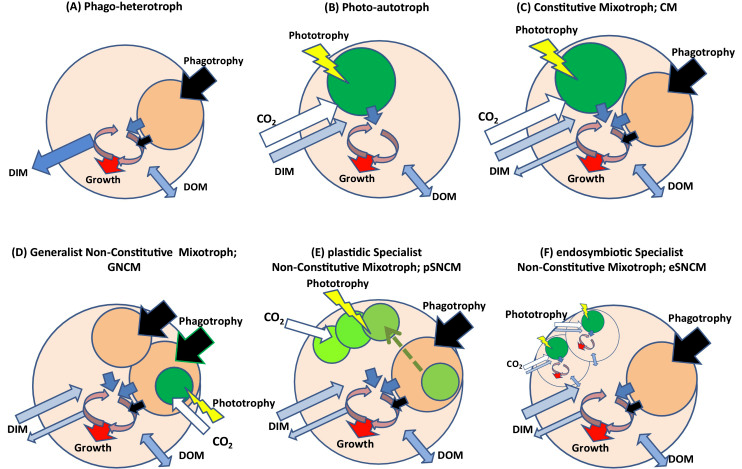This seems Quite Interesting.
https://www.nature.com/articles/s41467-022-28868-7
Mixotrophic plankton foraging behaviour linked to carbon export
This seems Quite Interesting.
https://www.nature.com/articles/s41467-022-28868-7
Mixotrophic plankton foraging behaviour linked to carbon export
buffy said:
This seems Quite Interesting.https://www.nature.com/articles/s41467-022-28868-7
Mixotrophic plankton foraging behaviour linked to carbon export
> Marine mixotrophic protists that use both heterotrophic and phototrophic metabolisms may impact the carbon cycle in unexpected ways. A recently characterized mixotroph can craft three-dimensional mucilage feeding structures that trap nutrient-rich plankton prey and contribute to the sinking of carbon from the surface ocean.
> Single-celled eukaryotes (protists)
My first question is why this should have anything to do with sinking.
> Their calculations suggest sinking carbon rates that range from 0.04–0.29 mg C m−2 d−1—increasing by approximately 4-fold if attached eukaryotes and prokaryotes are included in the estimation—and by 24-fold if the high cell densities under bloom conditions are considered. These maximum sinking carbon rates may rival those produced by much larger zooplankton which package fecal pellets and also discard gelatinous feeding structures and can be important vectors of organic carbon to the deep ocean. Mucouspheres produced by P. cf. balticum and other protistan species with similar foraging behaviour could therefore be significant and previously overlooked contributors to carbon export.
Still doesn’t explain sinking. Sinking only occurs if they’re not eaten (and don’t decompose in place) or it they have carbonate skeletons. And I don’t see any reference to either of those here.
Diatom single celled eukaryotes do considerably contribute to oceanic carbon capture because of their carbonate skeletons.
mollwollfumble said:
buffy said:
This seems Quite Interesting.https://www.nature.com/articles/s41467-022-28868-7
Mixotrophic plankton foraging behaviour linked to carbon export
> Marine mixotrophic protists that use both heterotrophic and phototrophic metabolisms may impact the carbon cycle in unexpected ways. A recently characterized mixotroph can craft three-dimensional mucilage feeding structures that trap nutrient-rich plankton prey and contribute to the sinking of carbon from the surface ocean.
> Single-celled eukaryotes (protists)
My first question is why this should have anything to do with sinking.
> Their calculations suggest sinking carbon rates that range from 0.04–0.29 mg C m−2 d−1—increasing by approximately 4-fold if attached eukaryotes and prokaryotes are included in the estimation—and by 24-fold if the high cell densities under bloom conditions are considered. These maximum sinking carbon rates may rival those produced by much larger zooplankton which package fecal pellets and also discard gelatinous feeding structures and can be important vectors of organic carbon to the deep ocean. Mucouspheres produced by P. cf. balticum and other protistan species with similar foraging behaviour could therefore be significant and previously overlooked contributors to carbon export.
Still doesn’t explain sinking. Sinking only occurs if they’re not eaten (and don’t decompose in place) or it they have carbonate skeletons. And I don’t see any reference to either of those here.
Diatom single celled eukaryotes do considerably contribute to oceanic carbon capture because of their carbonate skeletons.
I’ve only read the Scientific American article about the paper. But my understanding is that it’s the goo that sinks, not the plankton.
buffy said:
mollwollfumble said:
buffy said:
This seems Quite Interesting.https://www.nature.com/articles/s41467-022-28868-7
Mixotrophic plankton foraging behaviour linked to carbon export
> Marine mixotrophic protists that use both heterotrophic and phototrophic metabolisms may impact the carbon cycle in unexpected ways. A recently characterized mixotroph can craft three-dimensional mucilage feeding structures that trap nutrient-rich plankton prey and contribute to the sinking of carbon from the surface ocean.
> Single-celled eukaryotes (protists)
My first question is why this should have anything to do with sinking.
> Their calculations suggest sinking carbon rates that range from 0.04–0.29 mg C m−2 d−1—increasing by approximately 4-fold if attached eukaryotes and prokaryotes are included in the estimation—and by 24-fold if the high cell densities under bloom conditions are considered. These maximum sinking carbon rates may rival those produced by much larger zooplankton which package fecal pellets and also discard gelatinous feeding structures and can be important vectors of organic carbon to the deep ocean. Mucouspheres produced by P. cf. balticum and other protistan species with similar foraging behaviour could therefore be significant and previously overlooked contributors to carbon export.
Still doesn’t explain sinking. Sinking only occurs if they’re not eaten (and don’t decompose in place) or it they have carbonate skeletons. And I don’t see any reference to either of those here.
Diatom single celled eukaryotes do considerably contribute to oceanic carbon capture because of their carbonate skeletons.
I’ve only read the Scientific American article about the paper. But my understanding is that it’s the goo that sinks, not the plankton.
Ah, the mucus. That makes sense.
There are large areas of deep open ocean where the bottom is covered by “ooze”. Often this ooze is ascribed to pteropods, small oceanic snails, but not always.
https://en.wikipedia.org/wiki/Pelagic_sediment#Oozes
“Ooze is pelagic sediment that consists of at least 30% of microscopic remains of either calcareous or siliceous planktonic debris organisms. There are diatom, coccolith, foraminifera, globigerina, pteropod, and radiolarian oozes.”
Are any of these mixotrophic protists?
Mixotrophic protists include:
many Dinoflagellates, Dinobryon, Ochromonas …
Four different types of mixotrophs, from https://en.wikipedia.org/wiki/Mixotroph#Protists
